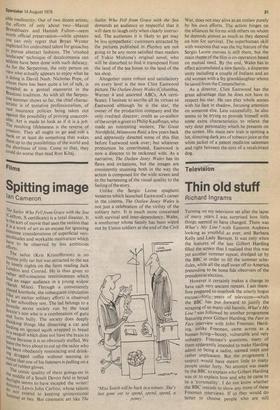Fil ms
Spitting image
Ian Cameron The Sailor Who Fell from Grace with the Sea (Carlton, X certificate) is a total disaster. It !s the sort of movie that uses the notion that IS a work of art as an excuse for ignoring "resome considerations of superficial verisimilitudes and workable motivation which have to be observed by less ambitious
efforts.
The sailor (Kris Kristofferson) is no r,outine jolly tar but was attracted to the sea ,°Y lonely nights on the farm reading Jack t'cindon and Conrad. He is thus given to rnather self-conscious reminiscences which "nd an eager audience in a young widow (Sarah Miles). Through a conveniently (13,1.a. eed knothole, the subsequent copulation L'IKe an earlier solitary effort) is observed her schoolboy son. The lad belongs to a jAuvenile secret society run by the local moctor's son who is a combination of guru !Pd. form bully. The society does deeply king things like dissecting a cat and t:euing an ignited squib wrapped in bread r" a seagull which does not have the brain to lefuse because it is so obviously stuffed. We heave the boys about to cut up the sailor who ;:s been obediently reminiscing and drink., g drugged coffee without seeming to LinIice that one of his listeners is pulling on a Pai.rl of rubber gloves. the comic quality of these goings-on in middle of a South Devon field in broad 4Ylight seems to have escaped the writer/ doreetnr, Lewis John Carlino, whose talents h., !Int extend to keeping qnintentional 'Inour at bay. But cinematic art like The
Sailor Who Fell from Grace with the Sea demands an audience so respectful that it will dare to laugh only when clearly instructed. The audiences it is likely to get may be less sympathetic: customers attracted by the pictures published in Playboy are not going to be any more satisfied than readers of Yukio Mishima's original novel, who will be disturbed to find it transposed from the land of the tea house to the land of the tea shop.
Altogether more robust and satisfactory on every level is the new Clint Eastwood picture The Outlaw Josey Wales (Columbia, Warner 4 and assorted ABCs, AA certificate). I hesitate to ascribe all its virtues to Eastwood although he is the star, the owner of the production company and the only credited director; credit as co-author of the script is given to Philip Kauffman, who made an interesting western, The Great Northfield, Minnesota Raid, a few years back and apparently directed some of this film before Eastwood took over; but whatever proportion he contributed, Eastwood is now a director to be reckoned with. As a narrative, The Outlaw Josey Wales has its flaws and irritations, but the images are consistently stunning both in the way the action is composed for the wide screen and in the harnessing of the visual quality to the feeling of the story.
Unlike the Sergio Leone spaghetti westerns which launched Eastwood's career in the cinema, The Outlaw Josey Wales is not just a celebration of the virility of the solitary hero. It is much more concerned with survival and inter-dependency. Wales, a southerner whose family has been wiped out by Union soldiers at the end of the Civil War, does not stay alive as an outlaw purely by his own efforts. The action hinges on the alliances he forms with others on whom he depends almost as much as they depend on him for survival. The superhuman skill with weapons that was the big feature of the Sergio Leone movies is still there, but the main theme of the film is co-operation based on mutual need. By the end, Wales has in effect accumulated a new family, a disparate unity including a couple of Indians and an old woman with a fey granddaughter whom he saved from the Comancheros.
As a director, Clint Eastwood has the great advantage that he does not have to respect his star. He can play whole scenes with his face in shadow, focusing attention on someone else. Less successfully, he also seems to be trying to provide himself with some extra characteristics to relieve the very dour personality which he presents on the screen. His main new trait is spitting a lot, directing dark jets of tobacco juice at the white jacket of a patent medicine salesman and right between the eyes of a recalcitrant dog.


























 Previous page
Previous page